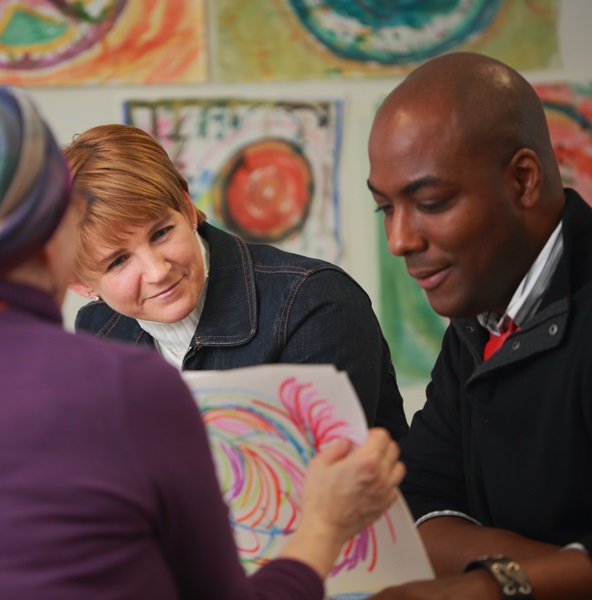Finding our Lanes in DEI: Using art as a starting place for action
February 21, 2022
 What is art therapy?
What is art therapy?
Art Therapy is an integrative mental health and human services profession that enriches the lives of individuals, families, and communities through active art-making, creative process, applied psychological theory, and human experience within a psychotherapeutic relationship. Art Therapy, facilitated by a professional art therapist, effectively supports personal and relational treatment goals as well as community concerns. Art Therapy is used to improve cognitive and sensory-motor functions, foster self-esteem and self-awareness, cultivate emotional resilience, promote insight, enhance social skills, reduce and resolve conflicts and distress, and advance societal and ecological change. (American Art Therapy Association, 2017)
Many people are confused about what art therapy is. It sounds a little mysterious or magical but looking art someone’s artwork is not like reading tea leaves. Yes, we may be moved by someone’s art, or their art may tell a story that their words cannot, or perhaps their art helps them find the words they could not before. But looking at the art, while meaningful, also requires context and relationship. Therefore, art therapists honor the creator and the meaning the artists give to the creation. Art therapists also recognize that art therapy is not just about the final product. Art therapy is about the therapeutic relationship between the art therapist and the client, the media and materials, the use of materials, and the process of making the art. There is much power in the creative and physical energy involved in art making and the stimulation and emotional responses spurred by various materials, the social climate, the current surroundings during the time of making, etc. All of these elements are essential in an art therapy session.
There is an upcoming Tuesday Topic called Finding our Lanes in DEI: Using art as a starting place for action. Is art therapy a part of this event?
 That’s a great question because the art will be a part of it but not therapy! Art can be therapeutic, which can be a part of art therapy at times but can also exist completely separate from it. Therapeutic art making does not require a relationship with an art therapist. Sometimes therapeutic art making is facilitated by an art therapist, resident artist, socially engaged or community artist, art educator or just someone who wants to make their own art. I am an art therapist and licensed professional counselor and will be present at the DEI “Finding Our Lanes” event with the intention to facilitate a therapeutic arts-based experience for attendees who may or may not consider themselves as skilled artists. To be clear, no art skills are required, and my presence is to be a support and to help people get started if they feel stuck.
That’s a great question because the art will be a part of it but not therapy! Art can be therapeutic, which can be a part of art therapy at times but can also exist completely separate from it. Therapeutic art making does not require a relationship with an art therapist. Sometimes therapeutic art making is facilitated by an art therapist, resident artist, socially engaged or community artist, art educator or just someone who wants to make their own art. I am an art therapist and licensed professional counselor and will be present at the DEI “Finding Our Lanes” event with the intention to facilitate a therapeutic arts-based experience for attendees who may or may not consider themselves as skilled artists. To be clear, no art skills are required, and my presence is to be a support and to help people get started if they feel stuck.
Can you explain how art can be a “starting place for action”?
Just like art can tell a story or help an artist find the words to say, art can also be a starting place for action. Poet Cesar A. Cruz wrote that, “Art should comfort the disturbed and disturb the comfortable.” In other words, our images and our creations can be a source of our power. They can be the inspiration to speak up and out, to make a statement, to dissent, to support, to agree and disagree, to raise awareness, to be seen, and to educate.
The purpose of the structured creative painting activity planned for the Tuesday Topic lays the groundwork for participants to have courageous conversations on race and ethnicity. The process of making the art together is intended to provide us opportunities to explore our similarities and differences, and to discover new ways of looking and understanding. At the end our time, participants will have a tangible art piece that symbolizes the space we shared and will live beyond our time together to carry the conversation forward. It will also give us a physical reminder that we have the option to take action and find our lanes in DEI beyond the art making session.
Finding our Lanes in DEI: Using art as a starting place for action
- When: Tuesday March 8, 2022, 4-5 p.m. ET
- Where: Center City Campus, Three Parkway, Room 1021 or via Zoom
Presenters:
- Veronica Carey, PhD, CPRP, assistant dean of Diversity, Equity and Inclusion and chair of Diversity, Equity and Inclusion; associate clinical professor, Counseling and Family Therapy
- Michele Rattigan, MA, ATR-BC, NCC, LCP, associate clinical professor, Creative Arts Therapies
- No artistic skills are required.
- Space for in-person is limited.
- Supplies are available for in-person, but not for on-line registration. On-line participants can follow along but will need to get their own supplies or can watch and do their own creative project such as reflective writing and creative witnessing and response art in another form.
People interested learning more about art therapy can check out www.arttherapy.org or contact Drexel Art Therapy and Counseling (ATC) faculty member Michele Rattigan.
Written by Michele Rattigan